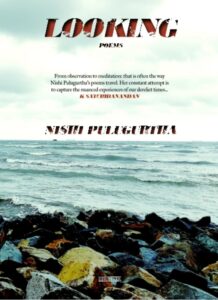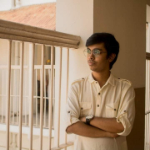A BOOK REVIEW BY OWSHNIK GHOSH
In recent years Red River has emerged as one of the leading book publishers, especially for Indian Anglophone poetry. It has been publishing a bulk of prominent poets this year. Nishi Pulugurtha’s Looking is one of them. Nishi is one of the significant voices in Indian poetry since the past one decade. Her poetry reveals the depth of human life in simple words. In the forward of her first poetry book ‘The Real and The Unreal’, esteemed scholar Sanjukta Dasgupta wrote on her poems as ‘refreshing assemblage of empirical observations glanced through the filters of empathetic perceptions and intellectual engagements’. Looking is her third book of poetry.
The train pulls up slowly
amidst the excitement,
the cacophony,
a push, a tug, a fall,
luggage clamouring in and up,
passengers running in, haphazard —
no one wants to miss
the train that will take us along
paths that are known,
unknown. To reach
a destination.
Home, maybe.
At first it seems that the poet is on her journey and we are the spectators. But as we move ahead from one poem to another, we find that we too are moving with her. She is not alone in the journey. The poems tell the stories of her personal journeys yet they are not her solely. We can see ourselves in them. The book is divided into three parts, the first part is named as “And They Tell Tales”. The poem named “The Journey”(mentioned above) portrays a simple picture of apparent day to day journey, but the readers come to a jerk at the last line. One may question oneself, is this a journey of life? Where we all are in search of a shelter which we can call our home. Will we ever be able to reach there? We don’t know where the train of life will take us.
The mood of the previous poem leads us to the next poem “The Bridge”. Here she sees life in the bustling city. The wheels and the traffic noise, all seems to speak, she tries to listen to them. Here too we can find a train which takes her across the bridge to a station with a name on its board. But that passes on. New stations with new boards arrive. Nothing is stagnant. One fades away, another one comes in. In a train journey one has to return. But when the name of the train is life, there is no return.
The journey goes on in the next poem (The Ghat) too. She describes the regular morning scene of a ghat by the river. Passers by look at the scene, glance and go on. Everyone has their unfinished works to be done. Everybody has to leave. Just like we glance at scenes passing by while travelling in a train or the incidents that pass by in our journey of life.
The journey of the poet is the journey of a woman too. Therefore in some of her poems, protest against ills towards women in our society play an important role. She portrays the binary between worshipping Goddesses as Mother and on the other hand rape and ill treating women in day to day life. Poems like “Time for the Goddess” and “We Worship the Goddess” are fine examples of this. On the other hand in the poem “Goddesses Around”, she describes the Goddess as an ordinary woman who lies on the station, dead. She fought against hunger, tried to feed her child but lost the battle against poverty. These lines strikes us-
The child held on to her sari,
tried to wake her up,
crying and calling.
She didn’t answer, she couldn’t answer —
she was just a woman,
a migrant returning home,
to uncertainty and poverty –
a woman for whom each day was a struggle.
We have often got the news of migrant labourers who had to go to far away states for earning were the ones who suffered the most during pandemic times. Governments declared lockdown without any concern for these people. We have witnessed thousands of migrant labourers were stuck at their working places due to the lockdown and couldn’t return home as there were no transport. Therefore they had to start walking from their workplace back home. It was almost an impossible venture because the places they were working in were hundreds of miles away from their homes. These were the people without income. We saw scattered chapatis on the railway tracks. In her poem the poet describes a heartbreaking story of these people :
She was not alone in this.
There were many others.
There still are many others
trying to work things out,
holding onto to life
in the best way they can,
the goddesses around us —
no, ordinary people like all,
struggling, fighting, living.
The portrait of an ordinary goddess is also reflected in another poem named What More Do You Want? The poet portrays a working woman stuck between her household and her professional work. She talks about the patriarchal obstacles that a working woman has to go through in our society.
By reading Nishi’s poems we can understand that she is concerned about the incidents which occur in our society. One of its fine example is the poem “The Little Boy’s House”. Here she is describing the story of a boy who lost his shelter during the super cyclone Amphan, which took place during the pandemic times. Through the boy’s story she represents thousands of people who lost their shelters and livelihood during that cyclone.
The poet’s dwelling city Calcutta plays a vital role in many of her poems. One of them is The City is My Sister Muse. Here she refers to her sister who lives far away from Calcutta but always walks down the memory lane. The dazzling memories of this city are always with her. Here we can sense the pain and the warmth of the memories that an individual nurtures away from the home. Physically they might leave their city but mentally they don’t.
The book is just not a collection of words but also photographs. The poet has made a combination of poetry and photography in a beautiful way. While turning the pages from one poem to another a reader can feel the thoughts conveyed through the photographs. They become a part of the words. The second part of the book is named “Looking”. It consists of simple poems with deep images. Poems like “The Morning Glory Plant”, “The Pen Stand on My Desk”, “The Green Mossy Concrete” have dispersed images from our everyday life. The images are in solitude and that solitude brings forth the depth of one’s life, where it seems the time has stopped. For example, if we take the poem “Yellow”, it describes an image of a tree beside the window of the staffroom. It has turned yellow in summer. Then she says :
tufts of the yellow hang down
green and yellow that shine beautifully,
as I look through older photographs —
there it is.
From an image of a tree with its yellow and green leaves it becomes a story of one’s life with yellow past in the photographs and living present, green.
In the poem “The Little Ones at Play”, the poet brings forth images of localities where there are binaries of restricted walls and freedom. Little children find their way out from the restrictions into the open space while playing, an old lady and an old gentleman out under the sky yet confined by walls. In our lives too we want to be free from restrictions and all boundaries but yet we can’t go beyond a certain limit surrounded by walls. But sometimes we also need a wall to lean onto. That gives us support in the infinite ocean of life; it’s like a stable anchor.
The pandemic period was a time without colours for most of us. But a poet’s eye manages to see colours in the most dull times too. “Holding On” and “Green Chillies” are two poems where the poet finds ‘a little bit of colour/ in colourless times.’ In cactus blooms or in the white flowers which are turning into green chillies, she sees life through them.
In another poem “The Mask is Always There”, she tells that we all wear masks every time in our day to day life. We remove it to put it on again. It has become a part of us in such a way that we don’t realise it. But in certain times we do feel it. Those are the times when our bonding with the world is tested.
The third part of the book is named as “Unheard Words”. The solitude of one’s being is prominent in the poems of this section. The basic question of our existence is uttered in these poems : ‘what to do’. She is looking for a door which will take her to her home, far from one’s day to day masked existence. Where one can be her/his real self with the close ones who may have parted. Where one can get shelter from all the struggles of life, off from this world which are broken down into fragments with boundaries each and every day. Doors take us to other places but is that the place where we wanted to be? We were in search of a home. In spite of all the long journeys have we reached our desired homes? Perhaps a place called home is nowhere outside ourselves, it’s inside us. We long to get there hustle and bustle, take different probable roads which may lead to it. Some of us do get there at some point of time and some never…
I see a door and open it.
It takes me to another place,
not home. I sit and wait
and then I look again.
They don’t know, I have to look
for a door to go home.
Also, read Agony of the Ghost and Other Stories, A book review by Dipanwita Bhattacharyya, published in The Antonym:
Follow The Antonym’s Facebook page and Instagram account for more content and exciting updates.



























0 Comments